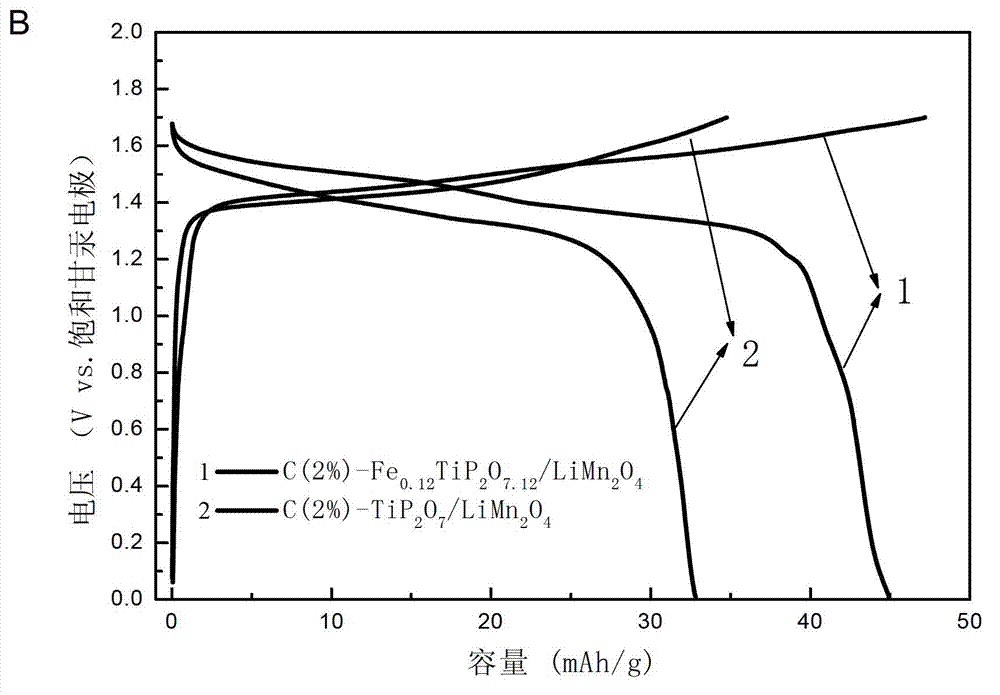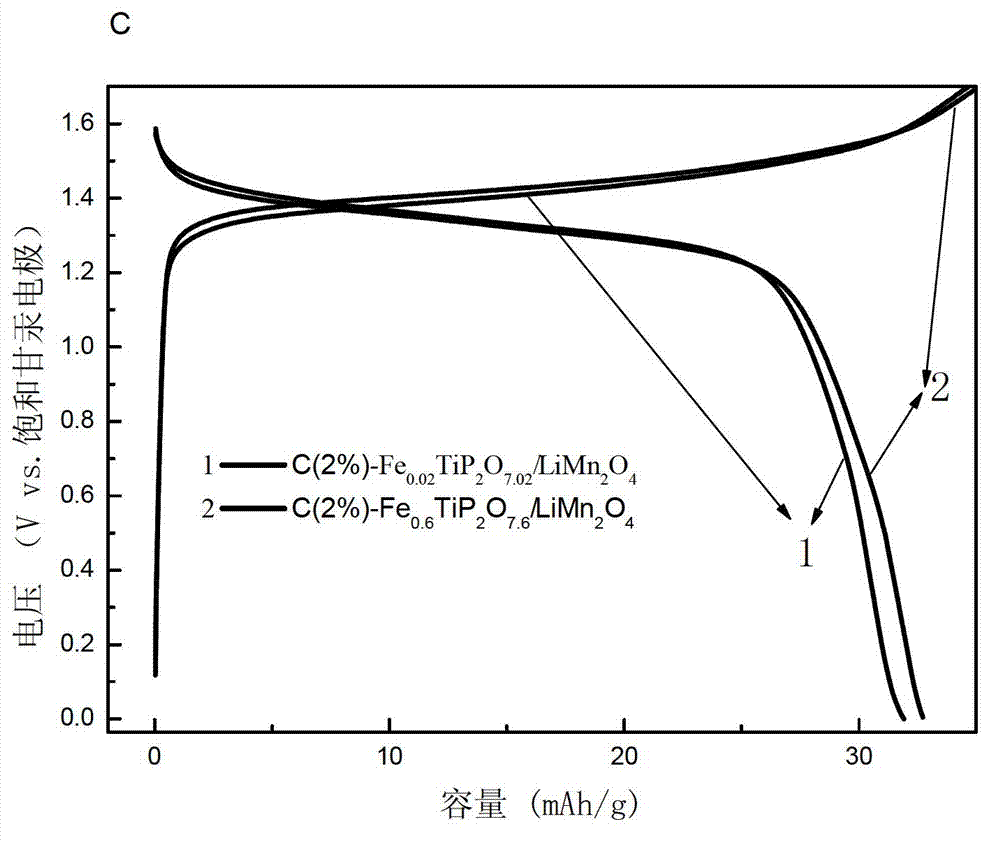Aqueous lithium ion battery with high properties
A lithium-ion battery and lithium-ion technology, applied in the field of electrochemistry, can solve problems such as poor cycle performance at small rates, and achieve the effects of low cost, high power, and long cycle life
- Summary
- Abstract
- Description
- Claims
- Application Information
AI Technical Summary
Problems solved by technology
Method used
Image
Examples
Embodiment 1
[0030] The positive electrode uses commercial grade spinel LiMn 2 o 4 , the slurry ratio according to LiMn 2 o 4 : conductive agent (acetylene black): binder (polytetrafluoroethylene) = 80:10:10 mixed slurry, then pressed into a film with a rolling mill, the above-mentioned pressed film was dried at a constant temperature at 100°C in a vacuum oven for 6 Hour.
[0031] The anode material uses pure TiP 2 o 7 , and its synthesis method is as follows: TiO 2 (1.20g, 15mmol) and NH 4 h 2 PO 4 (3.45g, 30mmol) were mixed and ground according to the stoichiometric ratio, then an appropriate amount (40mL) of distilled water was added, and the mixture was continuously stirred at 80°C until the mixture was dry. Finally, the above mixture was placed in a boat-shaped crucible, and then calcined in air at 700°C for 6 hours , namely TiP 2 o 7 .
[0032] Electrode preparation was as described above. In this embodiment, the actual capacity of the positive electrode material is 90mAhg...
Embodiment 2
[0035] The positive electrode uses commercial grade spinel LiMn 2 o 4 , the slurry ratio according to LiMn 2 o 4 : conductive agent (acetylene black): binder (polytetrafluoroethylene) = 80:10:10 mixed slurry, then pressed into a film with a rolling mill, the above-mentioned pressed film was dried at a constant temperature at 100°C in a vacuum oven for 6 Hour.
[0036] The negative electrode material uses carbon-coated TiP 2 o 7 , its synthetic method is as follows: with the TiP in embodiment 1 2 o 7 (3.33g, 15mmol) as the raw material, put it in a mortar and grind it into powder, then add 0.75% sucrose aqueous solution (21.4mL), stir continuously at 80°C until the mixture is dry, and finally put the above mixture in a boat crucible, and then calcined at 700 °C for 1 hour under nitrogen atmosphere to obtain carbon-coated C(2%)-TiP 2 o 7 .
[0037] Electrode preparation was as described above. In this embodiment, the actual capacity of the positive electrode material ...
Embodiment 3
[0040] The positive electrode uses commercial grade spinel LiMn 2 o 4 , the slurry ratio according to LiMn 2 o 4 : conductive agent (acetylene black): binder (polytetrafluoroethylene) = 80:10:10 mixed slurry, then pressed into a film with a rolling mill, the above-mentioned pressed film was dried at a constant temperature at 100°C in a vacuum oven for 6 Hour.
[0041] The negative electrode material is Fe 0.12 TiP 2 o 7.12 , its synthetic method is as follows: with the TiP in embodiment 1 2 o 7 As raw material, weigh TiP 2 o 7 (3.33g, 15mmol) and FeC 2 o 4 2H 2 O (0.324g, 1.8mmol) was placed in a mortar and mixed evenly, the above mixture was placed in a boat-shaped crucible, and then calcined at 700°C for 1 hour under a nitrogen atmosphere to obtain Fe 0.12 TiP 2 o 7.12 Material.
[0042] Electrode preparation was as described above. In this embodiment, the actual capacity of the positive electrode material is 90mAhg -1 , the actual capacity of the negative ...
PUM
| Property | Measurement | Unit |
|---|---|---|
| Areal density | aaaaa | aaaaa |
Abstract
Description
Claims
Application Information
 Login to View More
Login to View More - R&D
- Intellectual Property
- Life Sciences
- Materials
- Tech Scout
- Unparalleled Data Quality
- Higher Quality Content
- 60% Fewer Hallucinations
Browse by: Latest US Patents, China's latest patents, Technical Efficacy Thesaurus, Application Domain, Technology Topic, Popular Technical Reports.
© 2025 PatSnap. All rights reserved.Legal|Privacy policy|Modern Slavery Act Transparency Statement|Sitemap|About US| Contact US: help@patsnap.com



